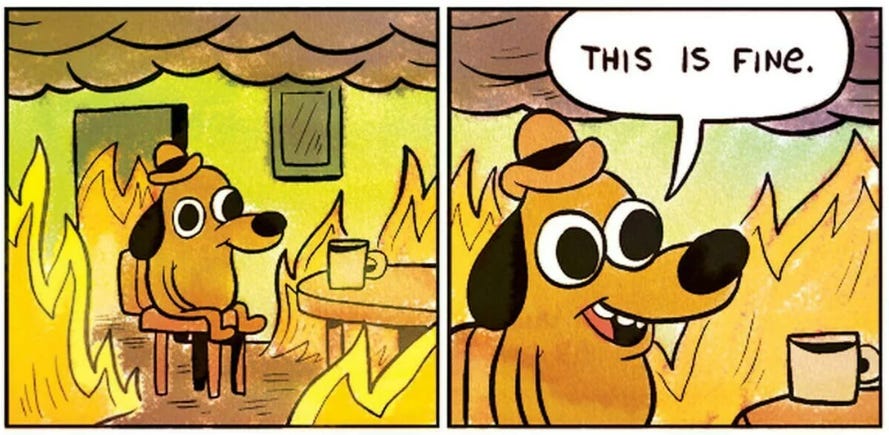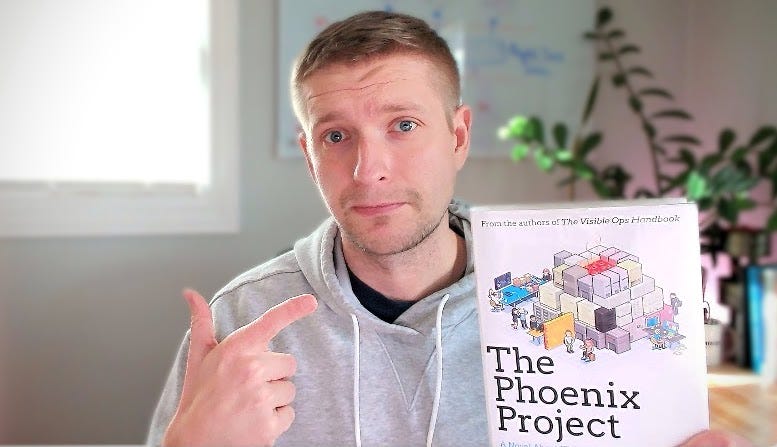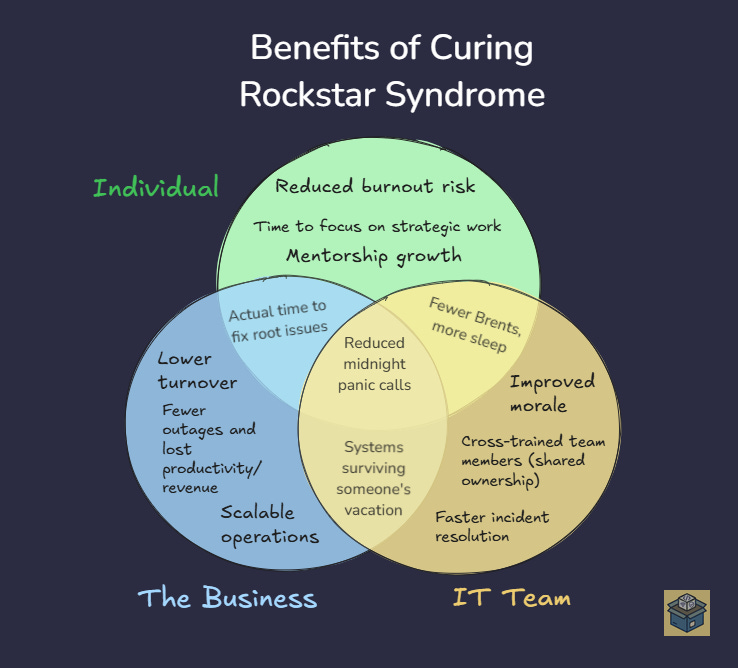Rockstar Syndrome: When Your IT Heroes Become Organizational Kryptonite
And How to Stop Playing Russian Roulette with Your Business Continuity
TL;DR
Relying on IT "rockstars" isn't heroism; it's playing Russian roulette with your business. These go-to experts become single points of failure, turning your team's strength into a ticking time bomb. When your rockstar burns out or bails, your operations are left hanging by a thread. IT leaders have got to dismantle this fragile setup by promoting knowledge sharing, thorough documentation, and team-wide problem-solving skills. Your goal? Build a resilient crew where no single person holds all the keys, ensuring your business doesn't crumble when your "hero" takes a hike.
Picture this: It’s 2 AM. Your lead system administrator is knee-deep in a silent server room that smells like anxiety, stale coffee, and existential dread. Servers are down, the warehouse crew is hours from mutiny (where’s your business continuity plan anyhow?) and for the sixth time this quarter you’re relying on one person’s ability to MacGyver a fix. Again.
“But they always figure it out!” you tell yourself.
This isn’t heroism, it’s organizational Russian roulette. And if you’re honest, you’ve known this for years. Time to dig into why we keep pulling the trigger.
The Corporate Hunger Games: Enterprise vs. Mid-Market
Walk into a Fortune 100 IT department and you’ll find:
Dedicated teams for every tech niche
Meetings about meetings about cloud strategy
Enough middle managers to start a golf league
Now enter a typical B2B company:
Your network admin moonlights as the ERP therapist
The IT Manager also support’s the CEO’s home network
Everyone’s calendar looks like a Tetris game from hell
It’s like comparing a symphony orchestra to a one-man band. Both make music, but one has the luxury of dedicated performers while the other is juggling instruments more than playing harmonics.
This duality creates a dangerous Convergence Zone where urgent fixes and long term strategy collide.
Survival here requires an adaptable team that can sway between the pendulums of averting crisis and strategically architecting technology. A common occurrence for most IT teams in traditional B2B organizations staffed between 10-50 FTEs.
On one end, being single threaded at crisis resolution becomes apparent immediately. Whereas on the other end of the spectrum at the strategic level, you won’t feel the impact of a rockstar missing between a Monday and a Tuesday.
This happens at both the team level, but even more so the individuals that make up the unit. This is where things get hairy.
Meet Brent: Your Company’s Biggest Liability
Anyone who's read "The Phoenix Project" knows Brent. Brent is the brilliant engineer who becomes both the hero and the single point of failure. He's the person everyone calls, the one who knows every system intricacy, the technical superhero who saves the day but inadvertently creates organizational fragility.
It's a trap that catches even the most well-intentioned teams. As Bill, Brent's manager in the book, laments, "Can't we do anything without Brent?" This isn't only a management frustration, it's a critical risk that derails entire technological ecosystems.
Brent is seemingly fantastic at his job, but he’s also:
The Keeper of Tribal Knowledge (documentation? never heard of her)
The Human API between departments that refuse to talk
The Walking Risk Register (PTO? ha.)
There are versions of Brent in just about every midsized B2B organization. In fact, it’s not limited to IT. You’ll find this person in Accounting, Sourcing, Logistics, Assembly, Welding, etc. Do you have this person?
Is there visible team anxiety when this person is out of office?
Is there one person who needs to be in EVERY important meeting?
Does your bus factor hover dangerously close to 1?
Can a new team member understand your systems/processes within a reasonable onboarding period?
This is traditionally a very tenured person or somebody who has got themselves involved in every big project or initiative and has a relentless drive to figure things out. I can attest to being that latter person and having to de-Brentify myself proactively due to the risk it bears as you fast forward in time. I’ve also inherited Brents.
It might be a bad sign if your organization is having a succession planning exercise and the topic of “Who is the biggest risk to this company?” comes up and that person is in your department. Source: Guilty.
The paradox is the more indispensable they become, they closer your company inches towards disaster. Brent is one missed alert away from rage-quitting to start an alpaca farm.
This hero culture works until it doesn’t. You find out VERY quickly how reliant your organization is not only on technology, but individuals, in order to operate. There’s more single points of failure than most people realize.
The High Cost of Hero Culture
Here’s the uncomfortable look in the mirror: Your “rockstars” are liabilities in disguise.
Every time Brent saves the day, you’re trading short term relief for long-term fragility and incentivizing knowledge hoarding.
Worse? You’re stunting your team’s growth. Juniors don’t become architects by watching Brent work. They learn by breaking things and then fixing them. Last but not least, you’re creating an invisible ceiling for your organization’s growth because no company can scale faster than its bottlenecks.
The Antidote: From Hero Worship to Collective Resilience
Fixing Rockstar Syndrome isn’t about cloning Brent, it’s about making the idea of Brent obsolete. I know that sounds harsh but we’re doing it in the healthiest way possible. Here’s how:
Start with process documentation, but make it meaningful. Don't create documentation for documentation's sake. Focus on capturing the critical decision points: Why did you choose this solution? What didn't work? What dependencies weren't obvious at first?
Create breathing room for knowledge transfer. This means carving out time when systems aren't on fire. Schedule regular technical deep-dives where your subject matter experts can share their expertise. Make it part of their job, not an afterthought.
Most importantly, redefine what success looks like. A team's strength isn't measured by how quickly your rockstar can fix a problem, it's measured by how many people can solve it independently. Track metrics that matter:
Number of incidents resolved without escalation
Percentage of critical systems with documented recovery procedures
Time spent on proactive improvements versus reactive firefighting
The goal isn't to make your technical experts obsolete—it's to free them to focus on more strategic work while building a more resilient organization. Because the best technical leaders don't create dependency; they create capability.
The New Rockstars: Teams That Thrive When Heroes Retire
Given most B2B IT budgets and how risk appetites are managed, you can only build and architect so much technical resilience like fail over, backups, or redundancies to mitigate as many issues as possible. There will always be issues that arise. You’ll also have a finite amount of human resources available.
Most IT organizations stop at the technical resilience portion. There are a significant amount of levers to be pulled in order to build people resilience within your team and for the betterment of the whole organization.
You’ll never have 100% people resilience, but getting it to the point of diminishing returns is something I would say is the exception to the rule, which is shocking considering the potential benefits all around.
The least you can do is try. As an IT leader, you need to be building resilient systems AND resilient teams. The business relies on it.
Your Turn: Break the Cycle Today
Leaders: Pick one system only your version of Brent understands. Schedule a knowledge transfer by EOD Friday.
Brents: Document one tribal secret this week. Share it.
Over the course of time, your rockstar firefighter will be able to spend more brain calories on the strategic end of the spectrum. This won’t happen overnight and it may be unnatural at first, but it will begin to develop a wide adaptable skillset that benefits the individual, team, you, and the business.
Final Perspective
Your organization's technological strength isn't measured by how quickly you solve problems, but by how well you transform individual smartness into collective capability.
The true rockstar isn't the person who knows everything—it's the team that can learn, adapt, and grow, with or without any single individual.
The only thing worse than a 2 AM crisis is knowing there’s only one person who can solve it.








